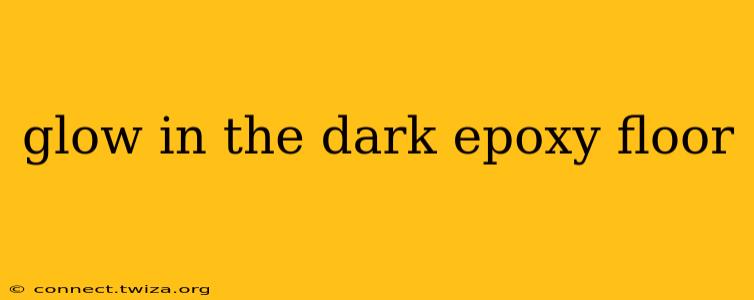Glow-in-the-dark epoxy floors have exploded in popularity, transforming ordinary spaces into mesmerizing, luminous environments. Whether you're aiming for a subtle nighttime ambiance or a dazzling, eye-catching spectacle, understanding the process and considerations is key. This guide dives deep into everything you need to know about achieving this striking effect.
What is Glow-in-the-Dark Epoxy Flooring?
Glow-in-the-dark epoxy flooring combines the durability and aesthetic appeal of epoxy coatings with the magical luminescence of phosphorescent pigments. These pigments absorb ambient light (sunlight, fluorescent lights, etc.) and release it slowly as a soft, ethereal glow in the dark. The epoxy acts as a protective layer, encasing the pigment and ensuring longevity and a smooth, seamless finish. The intensity and duration of the glow depend on several factors, including the type and quality of pigment used, the amount of ambient light absorbed, and the specific epoxy resin system.
How Does Glow-in-the-Dark Epoxy Flooring Work?
The magic lies in the phosphorescent pigments. Unlike fluorescent materials that require a continuous light source, phosphorescent pigments store energy from light exposure and gradually release it as light over several hours. This process is called phosphorescence. The longer the exposure to light, the brighter and longer-lasting the glow. The epoxy resin acts as a binder, holding the pigment particles evenly distributed throughout the floor, creating a consistent, luminous surface.
What are the Different Types of Glow-in-the-Dark Epoxy Pigments?
Several types of glow-in-the-dark pigments are available, each with its own characteristics:
- Aluminum Oxides: These offer a brighter, longer-lasting glow but can be more expensive.
- Zinc Sulfides: Generally less expensive, these offer a shorter glow duration.
- Rare Earth Pigments: These offer vibrant colors and exceptional glow performance, often seen in higher-end applications.
The choice of pigment significantly impacts the overall cost and performance of the glow-in-the-dark epoxy floor.
How Long Does the Glow Last?
The duration of the glow depends heavily on the pigment type and the amount of light exposure. High-quality pigments can glow for several hours after a sufficient charge, while lower-quality options may only glow for a shorter period. Generally, expect a gradual decrease in brightness over time, requiring recharging with exposure to light.
Can I Install Glow-in-the-Dark Epoxy Flooring Myself?
While possible, installing glow-in-the-dark epoxy flooring is a demanding DIY project. It requires precision, attention to detail, and a good understanding of epoxy resin application techniques. Poorly executed application can lead to uneven glow, imperfections in the finish, and a shorter lifespan. Consider hiring a professional epoxy flooring installer for optimal results, especially for larger projects.
What are the Costs Involved?
The cost of glow-in-the-dark epoxy flooring varies significantly depending on several factors: the size of the area, the type of pigment used, the quality of the epoxy resin, labor costs (if hiring a professional), and the location. Expect a premium price compared to standard epoxy flooring due to the specialized pigments.
What are the Maintenance Requirements?
Maintaining a glow-in-the-dark epoxy floor is relatively straightforward. Regular sweeping or vacuuming removes surface debris, while occasional mopping with a neutral cleaner keeps it clean. Avoid harsh chemicals or abrasive cleaners, as they can damage the epoxy coating.
Is Glow-in-the-Dark Epoxy Flooring Suitable for All Areas?
While adaptable to many spaces, factors like ambient light levels influence effectiveness. Areas with limited light exposure will have a dimmer glow. Consider the intended use and lighting conditions of your space before installation.
How Long Does it Take to Cure?
The curing time depends on the specific epoxy resin and environmental conditions (temperature and humidity). Expect a curing period of several days to a week before the floor is fully functional. The manufacturer's instructions should provide a detailed curing schedule.
This comprehensive guide provides a solid foundation for understanding glow-in-the-dark epoxy flooring. Remember to thoroughly research and choose products from reputable suppliers to ensure the best results and a long-lasting, luminous floor.
